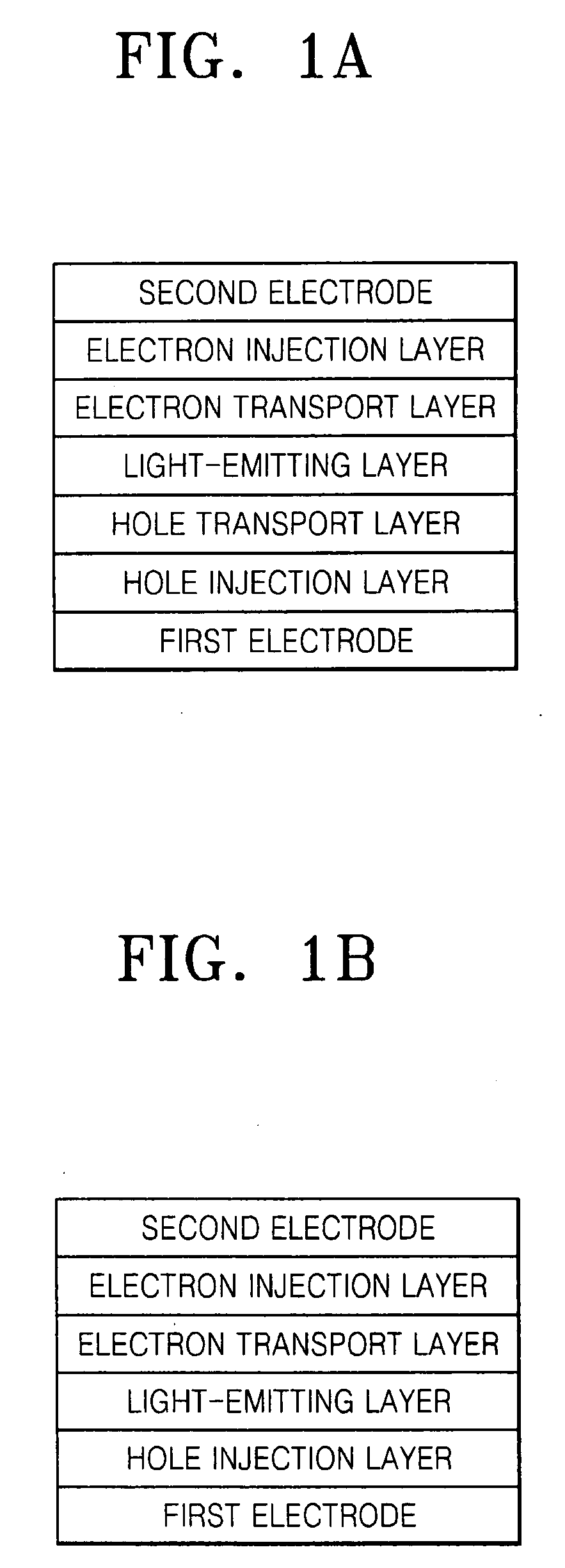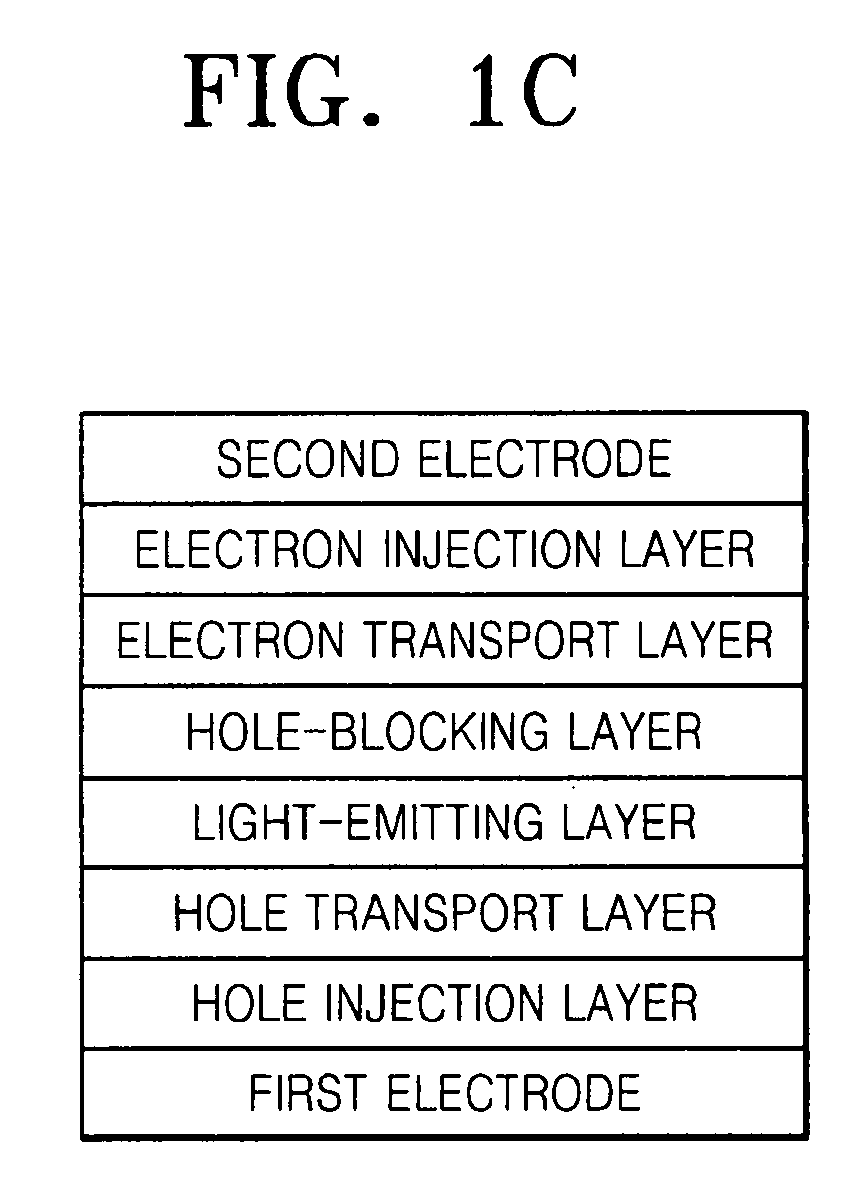Cyclopentaphenanthrene-based compound and organic electroluminescent device using the same
a technology of cyclopentaphenanthrene and compound, which is applied in the direction of discharge tube luminescnet screen, other domestic articles, organic chemistry, etc., can solve the problems of poor thermal stability, color purity, thermal stability, etc., of light-emitting molecules of materials that can be used in the solution coating process, and achieve good thermal stability, emission characteristics and charge transport
- Summary
- Abstract
- Description
- Claims
- Application Information
AI Technical Summary
Benefits of technology
Problems solved by technology
Method used
Image
Examples
synthesis example 1
1) Synthesis of 8,9-dihydro-4H-cyclopenta[def]phenanthrene
[0104]4H-cyclopenta[def]phenanthrene (4.75 g, 25 mmol) was placed in a Par reactor bottle, and EtOH (200 ml) was added thereto. 5% Pd / C (3.99 g) was added to the reaction solution, and the resultant solution was incubated under a hydrogen pressure of 40 psi for 24 hours. After the reaction was terminated, the reaction solution was filtered, and the filtrate was concentrated under a reduced pressure to give a white product (4.42 g, 90%).
[0105]1H NMR (300 MHz, CDCl3, δ): 7.36(2H, d), 7.21(2H, t), 7.12(2H, d), 3.90(2H, s), 3.16 (4H, s)
2) Synthesis of 2,6-dibromo-8,9-dihydro-4H-cyclopenta[def]phenanthrene
[0106]8,9-dihydro-4H-cyclopenta[def]phenanthrene (4.42 g, 23 mmol) was placed in a 250 ml round bottom flask (RBF), and CCl4 (100 ml) was added thereto. The reaction mixture was cooled to 0° C., and Br2 (7.72 g, 48 mmol) was dropwise added thereto. The reaction solution was incubated for 4 hours and a 10% NaSO3 solution was added...
synthesis example 2
[0113]1) Synthesis of Compound 3
[0114]2,6-dibromo-4H-cyclopenta[def]phenanthrene (2.6 g, 7.7 mmol) and octyl bromide (3.6 g, 18.5 mmol) in a 50 ml round bottom flask were dissolved with toluene (10 ml), and TBAB (tetrabutylammoniumbromide) (0.125 g, 0.385 mmol) was added thereto. A solution of NaOH (3.1 g, 77 mmol) in water (50 ml) was added to the reaction mixture, and the resultant solution was refluxed for two days. After the reaction was terminated, the reaction solution was extracted with chloroform. The organic layer was dried over MgSO4, concentrated, and purified by silica gel column chromatography (eluent: n-hexane). The eluate was distilled under a reduced pressure to remove unreacted octyl bromide, thereby giving a compound 2 (3.6 g, 80%).
[0115]1H NMR (300 MHz, CDCl3, δ): 7.98(2H, s), 7.79(2H, s), 7.73(2H, s), 1.93(m, 4H), 1.21(m, 20H), 0.87(m, 6H), 0.65(broad s, 4H)
[0116]2) Synthesis of Material 2(Formula 10)
[0117]The compound 2 (1 g, 1.747 mmol), diphenylamine (0.88 g, ...
synthesis example 3
1) Synthesis of 2,6-dibromo-cyclopenta[def]phenanthren-4-one
[0119]Benzene (200 ml) was placed in a 250 ml round bottom flask, and the compound 1 (3.6 g, 10.4 mmol) was added thereto. MnO2(150 g) was added to the reaction mixture, and the resultant mixture was heated and refluxed in an oil bath for 18 hours. After the reaction was terminated, the reaction solution was filtered to remove MnO2, and sufficiently washed with CHCl3, THF, and MeOH in sequence. The filtrate was concentrated under a reduced pressure and the residue was recrystallized from acetone to give the titled compound (1.45 g, 39%).
[0120]1H NMR (300 MHz, CDCl3, δ): 8.08 (2H, s), 7.89(2H, s), 7.74(2H, s)
2) Synthesis of Intermediate A
[0121]2-bromobiphenyl (0.68 g, 2.95 mmol) was dissolved in anhydrous THF (10 ml), and the reaction mixture was cooled to −78° C. Then, t-BuLi (3.5 ml) was gradually dropwise added. The reaction mixture was stirred for one hour, and a solution of 2,6-dibromo-cyclopenta[def]phenanthren-4-one (...
PUM
| Property | Measurement | Unit |
|---|---|---|
| Solubility (mass) | aaaaa | aaaaa |
| Transport properties | aaaaa | aaaaa |
| Stability | aaaaa | aaaaa |
Abstract
Description
Claims
Application Information
 Login to View More
Login to View More - R&D
- Intellectual Property
- Life Sciences
- Materials
- Tech Scout
- Unparalleled Data Quality
- Higher Quality Content
- 60% Fewer Hallucinations
Browse by: Latest US Patents, China's latest patents, Technical Efficacy Thesaurus, Application Domain, Technology Topic, Popular Technical Reports.
© 2025 PatSnap. All rights reserved.Legal|Privacy policy|Modern Slavery Act Transparency Statement|Sitemap|About US| Contact US: help@patsnap.com



